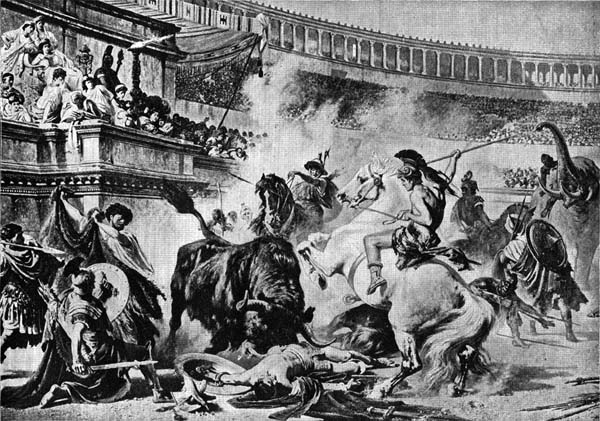
"Bull-Fight in the Arena". Alexander von Wagner (1838-1919)
It was in ancient Greece that men and bulls first contended in the arena for the amusement of the public. In later days, when the sceptre of the Caesars ruled the world, the Roman populace feasted their sight upon the same sport. In the nineteenth century bull-fighting is still the favorite pastime of Spain and Mexico. Formerly the Spanish monarchs instituted this cruel sport as a source of revenue. At present it is held for private speculation or for the benefit of public institutions. In Madrid the bull-fighting season begins in April and lasts till November. The sport takes place in a kind of circus, called the Plaza del Toros.
The bull-fight has been described as a tragedy in three acts. There are three orders of human contestants : first, the picadores who are mounted and armed with lances, who take up their position in the centre of the circus, opposite the bull-stalls; second, the chulos, who are on foot, and wearing bright-colored cloaks; and third, the matador, or chief combatant, who is also on foot, armed with a sword and a small muleta (stick) with a scarlet ribbon attached. The picadores are the first to engage the bull, and as their horses are wounded and killed they retire from the scene, and the chulos rush in, attracting the bull by their cloaks, and saving themselves if need be by leaping over the palisade. Short darts, ornamented with paper and flags, are stuck by the chulos in the bull's neck. The matador now advances alone to complete the fight. With the muleta he infuriates the animal, which generally rushes wildly at it, and then the matador plunges his sword “between the left shoulder and the blade," and the bull has made his last charge.
Alexander Wagner, born at Pesth, Hungary, was educated at Munich under Piloty, and at the age of twenty-eight became a professor. He is noted for his force and accuracy in the representation of the arena in the Roman Classic period. He considers his masterpiece to be the "Chariot Race," shown elsewhere in this collection.
(This text is a digital copy of a book, "Franklin Edson Belden:Historic Men and Scenes". This book, published in 1898, is already in the public domain.)